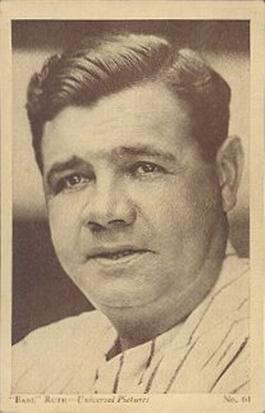September 11, 1931: Babe Ruth hits into triple play as late-season struggles deny him AL batting title
 Babe Ruth’s offensive domination has been well documented.1 From 1919 through 1930, his name was often at the top of the offensive lists for runs scored, runs batted in, bases on balls, and on-base percentage. Perhaps more impressively, he led his contemporaries in power statistics: home runs, slugging percentage, and total bases in the season, leading either the American League or both the American and National Leagues. In all of those offensive categories, he had either the highest or second-highest total in major-league history when he retired in 1935.
Babe Ruth’s offensive domination has been well documented.1 From 1919 through 1930, his name was often at the top of the offensive lists for runs scored, runs batted in, bases on balls, and on-base percentage. Perhaps more impressively, he led his contemporaries in power statistics: home runs, slugging percentage, and total bases in the season, leading either the American League or both the American and National Leagues. In all of those offensive categories, he had either the highest or second-highest total in major-league history when he retired in 1935.
Perhaps overlooked among Ruth’s array of batting skills was his ability to hit for average. His career batting average of .342 ranks 13th-best all-time as of 2025. He led the AL in batting once – in 1924, with a .378 mark2 – and he finished in the league’s Top Five seven other times.
In 1931, with just two weeks left in the regular season, the race to win the AL batting title was a two-player contest. Ruth, in his 12th season with the New York Yankees, was virtually tied with Al Simmons of the Philadelphia Athletics. It had been a while since Ruth challenged for the league lead in batting average. In 1926, two seasons after his batting crown, Ruth’s .372 average was second to Heinie Manush of the Detroit Tigers, who hit .378. Now, five seasons later, at the age of 36, Ruth was vying once again for the highest batting average in the league.
The two-time-defending World Series champion Philadelphia Athletics had all but locked up the pennant in the junior circuit. As play ended on September 10, the A’s held a 13-game lead over the second-place Washington Nationals. Although the Yankees had scored 936 runs – 164 more runs than the Athletics – the Bronx Bombers were in third place, already eliminated from winning the pennant.
Simmons, Philadelphia’s 29-year-old star left fielder, stood (or rather, batted) in Ruth’s way. In 1929, the Athletics’ first championship season, he led the AL with 157 RBIs while batting .365. Simmons had captured the junior circuit batting crown in 1930, with a 381 mark.
Despite holding out until Opening Day in 1931,3 Simmons was the only Athletics player to appear in every game of the season from the opener until August 15.4 Then he suffered an injury, when his left ankle became “covered in blisters”5 and needed attention from the trainer every day. He missed the next 21 games before returning to the lineup on September 6. Simmons went hitless in his first two games back, marking the first time since April that he had not collected a hit in three straight games. Then he was 2-for-4 against the St. Louis Browns on September 10. Now, with 14 games left to play, Simmons was hitting at a .380 clip.
Ruth was also ailing. He and the Yankees played in an exhibition game on September 8 in Wilkes-Barre, Pennsylvania. According to the New York Times, Ruth had “brought home”6 a bruise to his hand from the game. Fortunately, Ruth could rest a few days until the Chicago White Sox visited Yankee Stadium on September 11, but his hand had to be taped by the trainers. A reported crowd of only 4,000 came out to watch the first of a three-game series. New York’s Hank Johnson (12-7) faced off against Chicago’s Ted Lyons (2-4).
Chicago’s Lu Blue led off the game by reaching second on a pop fly that Yankees second baseman Tony Lazzeri muffed. Blue advanced to third on a groundout and scored on Smead Jolley’s fly ball to deep right.
In the bottom of the first inning, New York’s Earle Combs led off with a single to right. Joe Sewell reached on a walk, and Ruth came to the plate.
Marshall Hunt of the New York Daily News described the scene: Ruth “jammed his cleats vigorously into the rust-colored soil about the plate at Yankee Stadium and, after making several preliminary gestures with his heavy wooden utensil, swished it malevolently from behind his great noggin”7 and grounded the ball toward third baseman Billy Sullivan.
Sullivan snared the grounder, tagged out Combs, and threw to Johnny Kerr at second base. Kerr stepped on the bag, forcing out Sewell, and then threw to first baseman Blue, who squeezed the ball before Ruth touched the bag, completing a triple play. This was the only time in Ruth’s 10,628 career plate appearances that he hit into a triple play. The no-out rally was instantly killed and New York never really threatened for the rest of the game.
The New York Times reported that Ruth had the “painful distinction”8 of hitting into a triple play. Not only had a scoring opportunity been eliminated, but Ruth had reinjured his right hand, which “suffered such a jolt”9 that he was removed from the game. Samuel Byrd entered the game in the top of the second, playing right and batting third.
Johnson retired the White Sox in order in the second, but then he allowed singles to Frank Grube and Lyons to start the top of the third. With runners at the corners, Blue’s fly to deep right field brought Grube home with Chicago’s second run.
Lyons retired the Yankees in order only once through the first five innings, but he had a two-run lead. Then Combs led off the bottom of the sixth with a home run well past the wall in right, his third of the season.10 It was the only damage the Yankees would muster against Lyons.
Chicago finished the scoring by adding a run in the eighth. With Ed Wells in relief of Johnson, Blue led off with a single to left. Sullivan sacrificed him to second, and an out later, Blue scored on Lew Fonseca’s single into right field.
Lyons – a future Hall of Famer limited to 12 starts in 1931 by a sore shoulder – allowed only one run on 11 hits. Lou Gehrig, on his way to leading the AL in home runs, RBIs, runs, and hits, managed only one ball out of the infield in an 0-for-4 day. Johnson fell to 12-8 with the loss.
Ruth had gone 5-for-9 in a September 7 twin bill against the Athletics (Simmons did not play), raising his average to .380. He went 0-for-1 on September 11 and 0-for-1 as a pinch-hitter in each of the next day’s doubleheader games against the White Sox. He continued his slump with a combined 0-for-5 in two games against the Detroit Tigers.11
His batting average dropped to .373 over that five-game stretch. A 16-for-44 (.364) stretch in his final 12 games maintained that average. In 1931 Ruth had put together a 16-game hitting streak and a 30-game on-base streak, but with the late-season slump, it was not enough to catch Simmons (.390). The Athletics’ future Hall of Famer hit safely in every game from September 10 through September 27 (26-for-54).
There were eight triple plays turned in 1931, six in the AL and two in the NL. Only Ruth’s was of the “around-the-horn” (5-4-3) variety. Again, this was the only triple play that Ruth ever hit into in his big-league career.12
The 1931 season marked the inaugural awarding of the Most Valuable Player Award, voted by members of the Baseball Writers’ Association of America. Athletics pitcher Lefty Grove garnered the honor, ahead of both Simmons (third) and Ruth (fifth).13 Ruth’s teammate Gehrig finished second in the award voting.14
Acknowledgments
This article was fact-checked by Carl Riechers and copy-edited by Len Levin.
Sources
In addition to the sources mentioned in the Notes, the author consulted Baseball-Reference.com, MLB.com, Retrosheet.org, and SABR.org.
https://www.baseball-reference.com/boxes/NYA/NYA193109110.shtml
https://www.retrosheet.org/boxesetc/1931/B09110NYA1931.htm
Notes
1 As a measure of consistency, Ruth batted .343 with 271 home runs with none on base and .352 with 274 homers with men on (not in scoring position); with runners in scoring position, Ruth hit .351 with 146 home runs. He batted .315 in games in which he pitched. He slugged .698 at home and .682 away. See Mike Huber, “How ‘Ruthian’ was Babe Ruth?,” in The Babe, Bill Nowlin and Glen Sparks, eds. (Phoenix: Society for American Baseball Research, 2019). This article is also online at https://sabr.org/journal/article/how-ruthian-was-babe-ruth/.
2 Ruth missed out on capturing the American League Triple Crown in 1924. He led the AL with a .378 batting average and led both leagues with 46 home runs. His 124 RBIs, tied with Yankees teammate Bob Meusel, were second to Washington’s Goose Goslin (129). New York Giants star George Kelly drove in 136 to lead all National League batters.
3 Fred Stein, “Al Simmons,” SABR Biography Project. Accessed July 2025. Simmons signed a three-year, $100,000 contract.
4 “Mackian Close-ups,” Philadelphia Inquirer, August 16, 1931: 94.
5 “Mackian Close-ups.”
6 William E. Brandt, “Yankees Lose, 3 to 1, Triple Play Helping White Sox Win,” New York Times, September 12, 1931: 11. The Yankees had played the Wilkes-Barre Barons on Tuesday, September 8, defeating the Barons 7-4 in front of approximately 4,500 fans. Ruth had gone 1-for-5, but that hit was a 3-run RBI single. Neither the Wilkes-Barre Times Leader (“Ruth and Gehrig provide thrills for Valley fans,” Wilkes-Barre Times Leader, September 9, 1931: 15) nor the Wilkes-Barre Record (“Gehrig and Ruth Deliver Smacks That Beat Barons,” Wilkes-Barre Record, September 9, 1931: 18) reported that Ruth had sustained an injury.
7 Marshall Hunt, “Ruth Drives Into Triple Play, Sox Win,” New York Daily News, September 12, 1931: 156.
8 “Yankees Lose, 3-1, Triple Play Helping White Sox Win.”
9 “Yankees Lose, 3-1, Triple Play Helping White Sox Win.”
10 This was Combs’’ eighth big-league season and just his 37th major-league home run. Predominantly New York’s leadoff batter, his job was to get on base and come around to score. This ability got him elected into the Hall of Fame by the Veterans Committee in 1970.
11 Until the injury, Ruth had not gone more than two consecutive games without a base hit. In fact, Ruth had just three different stretches of two games, where he was hitless, before he injured his hand.
12 Without looking at every box score of games Ruth played, we do not have data on how many times Ruth grounded into a double play, so no comparisons can be drawn. That statistic was first kept in 1933 in the National League, but not until 1939 in the American League.
13 According to ESPN.com, “The award began in 1911 as the Chalmers Award, honoring the ‘‘most important and useful player to the club and to the league.’’ That award was discontinued in 1914. From 1922 to 1928 in the AL and from 1924 to 1929 in the NL, the League Award was presented to ‘‘the baseball player who is of the greatest all-around service to his club. Prior winners were not eligible to win the award again during that time.” See Keith Jenkins, “Who has won the MLB MVP Award? All-time winners list,” found online at https://www.espn.com/mlb/story/_/id/42367618/who-won-mlb-mvp-award-all-winners-list. Accessed February 2025.
14 The day after this game, the Victoria (British Columbia) Times Colonist reported, “While Ruth and Simmons were battling for the [batting average] leadership, Lou Gehrig, the Yanks’ slugging first baseman, continued to demonstrate he is the best all-around batsman in the junior circuit, by leading in five departments. He had forty-two home runs, had scored 147 times and had total bases amounting to 375, along with having made 193 hits to drive in 168 runs.” In fact, Gehrig had 169 RBIs to this point. “Big League Stars Stage Keen Races for Batting Titles,” Victoria (British Columbia) Times Colonist, September 12, 1931: 9. The Iron Horse finished the season leading the majors in home runs (46), RBIs (185) and runs scored (163), while topping the AL in hits (211).
Additional Stats
Chicago White Sox 3
New York Yankees 1
Yankee Stadium
New York, NY
Box Score + PBP:
Corrections? Additions?
If you can help us improve this game story, contact us.

